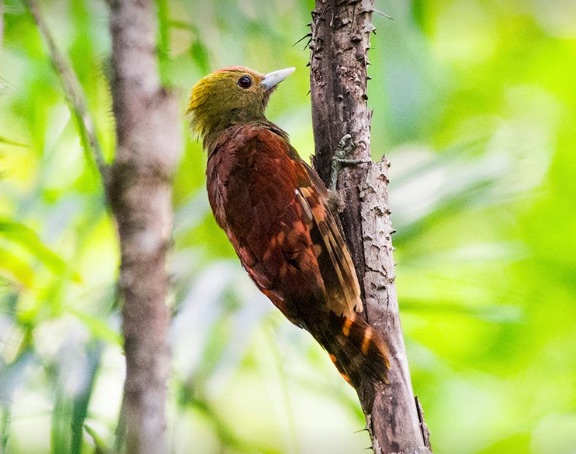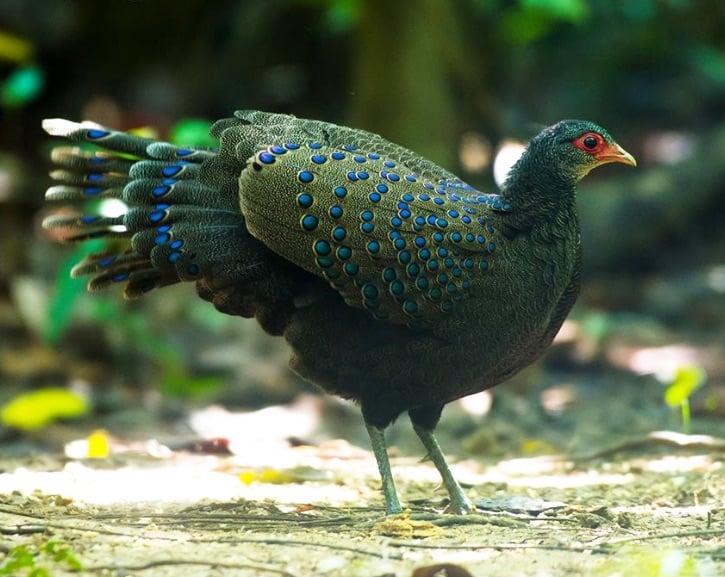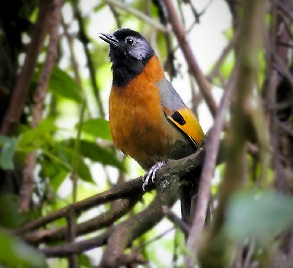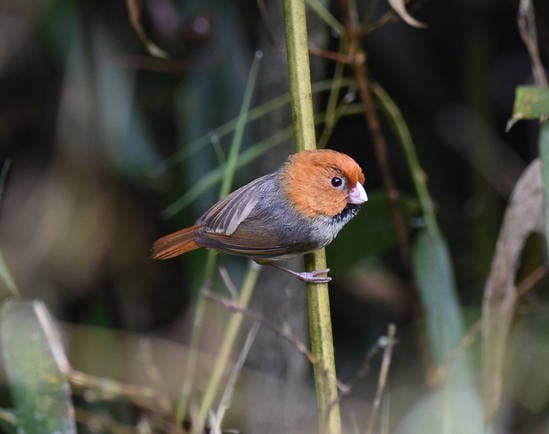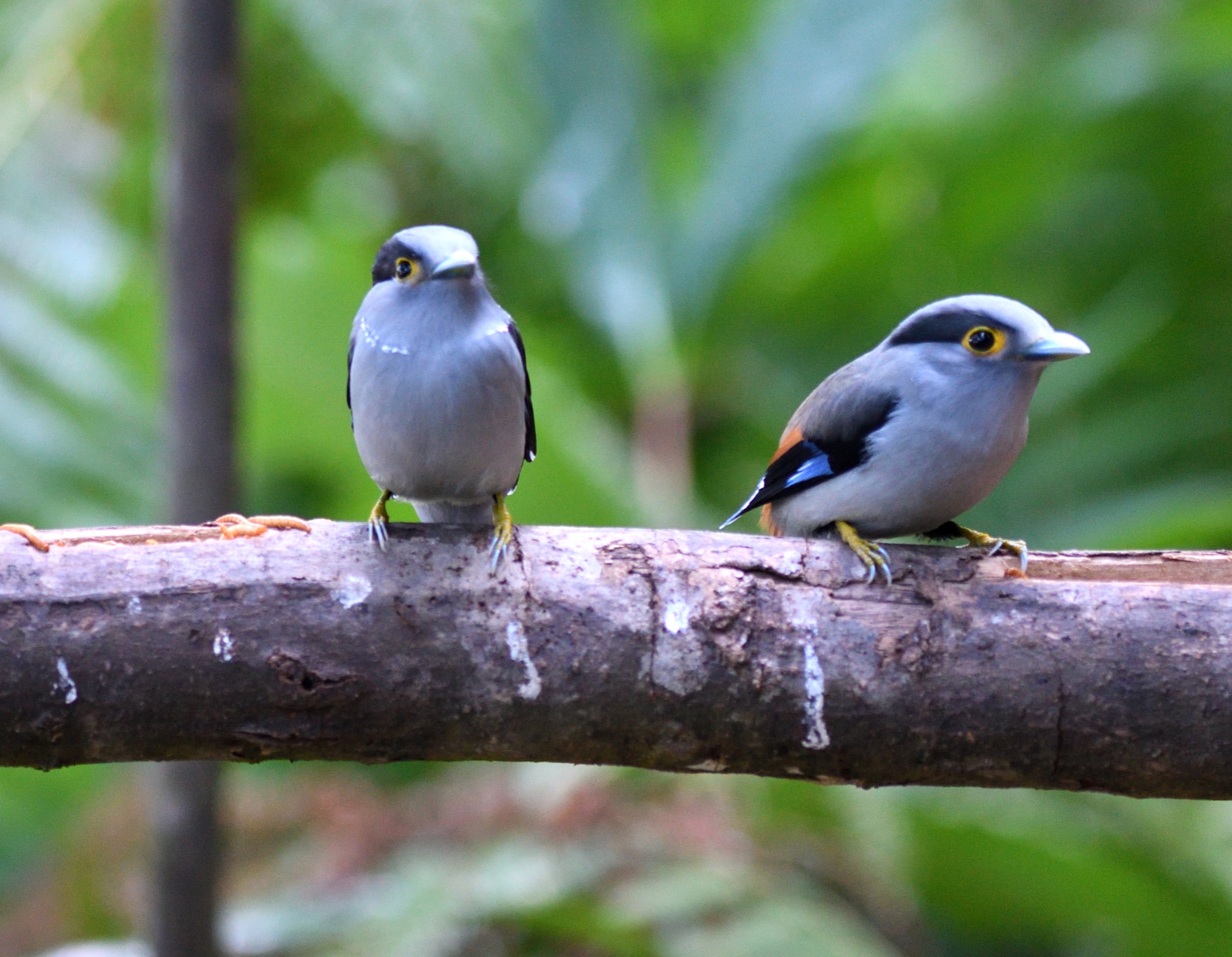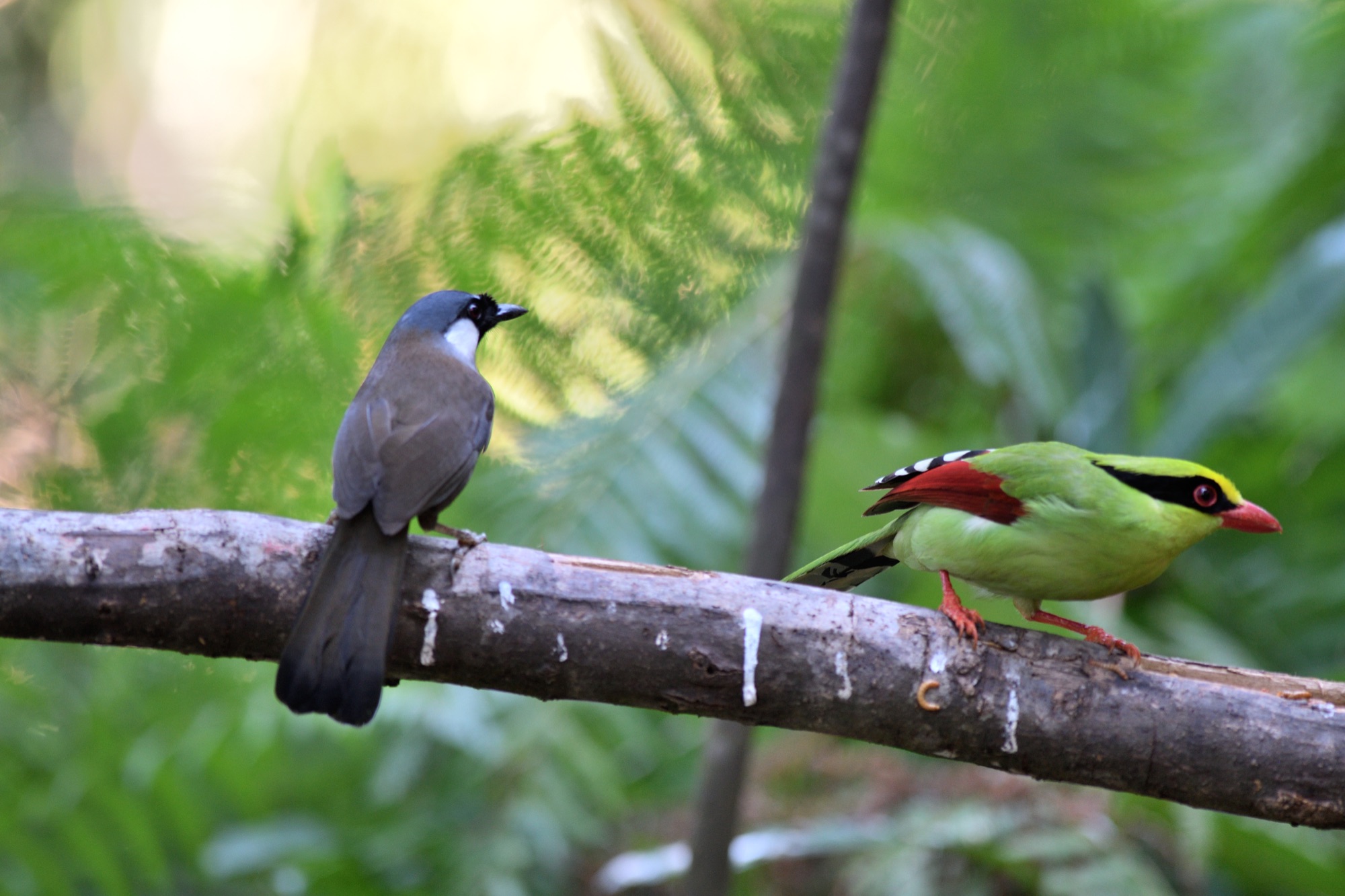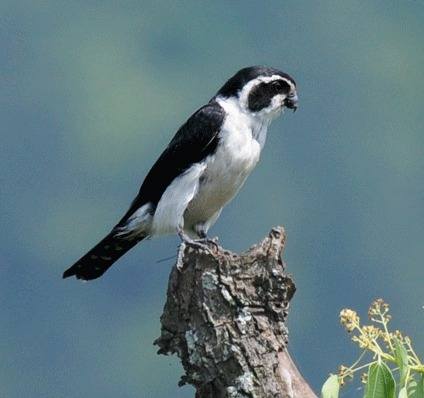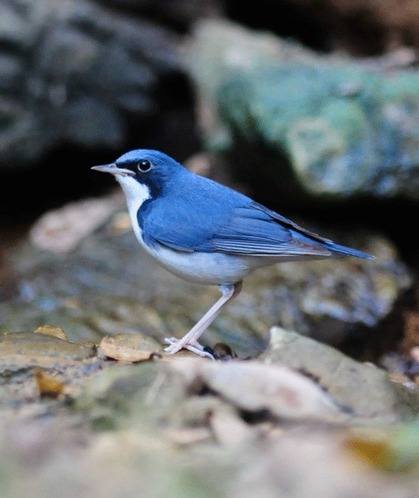VIETNAM - Detailed Tour Itinerary
Day 0 Arrival to Ho Chi Minh City - 5th January
Overnight scheduled direct flight from London to Ho Chi Minh City (formerly Saigon), Vietnam, and transfer to hotel. Please note this is purely an arrival day and no activities are planned. Night in Ho Chi Minh City.
Day 1 Ho Chi Minh City - Tan Phu
We will leave Ho Chi Minh City early and drive to Tan Phu, a drive of 140kms to the north. We will then spend the rest of the day targetting Bar-bellied & Blue-rumped Pittas. While this area holds two endangered species of primates - Black-shanked Douc Langur and Yellow-cheeked Gibbon. Overnight at Suoi Mo Resort.
Day 2 Tan Phu Forest
Tan Phu is located in Dong Nai province, situated in a lowland area at an elevation of around 300 m. To the south and east, the forest enterprise is bordered by the La Nga River, while the La Canh and Gian Lai streams form the northern boundary, and the Tra My stream forms the western boundary. The forest encompasses a total area of 13,967 ha.
During our full day at Tan Phu forest we will again target both Bar-bellied and Blue-rumped Pittas if we didn't get them yesterday. And there's plenty of other great birds present here including Orange-necked Partridge, Germains’s Peacock-Pheasant and Siamese Fireback. A fine supporting cast of more widespread Asian species are also present such as Green-legged Partridge, Black-and-buff and Pale-headed Woodpeckers, Abbott’s, Puff-throated & Buff-breasted Babblers, Black-and-Red, Banded & Dusky Broadbills, Banded Kingfisher and Orange-breasted Trogon. And at night we could see Collared Scops Owl, Asian Barred Owlet and Brown Boobook. Overnight at Suoi Mo Resort.
Day 3 Tan Phu - Cat Tien NP
After a final mornings birding at Tan Phu we will head to Cat Tien National Park where we should arrive in time for some easy afternoon birding amidst the grassland and wetlands looking for Lesser Adjutant, Woolly-necked Stork and Green Peafowl while commoner species should include Cinnamon Bittern, Black-backed Swamphen, Bronze-winged Jacana, Lesser Coucal, Stork-billed Kingfisher, Chestnut-headed Bee-eater, Bronze-winged Jacana, Red-breasted Parakeet, Indochinese Bushlark, Chestnut-capped Babbler, Rufescent Prinia, Racket-tailed Treepie, occasionally Asian Golden Weaver, and some Palearctic migrants should be around such as Brown Shrike, Siberian Rubythroat, Lanceolated, Thick-billed, Pale-leagged Leaf, Two-barred, Radde's and Dusky Warblers, Black-browed and Oriental Reed Warblers and others. Raptors watching can be rewarding here with the possibility of Black Baza, Crested Goshawk, Crested Honey Buzzard, Collared Falconet and perhaps even Grey-headed Fish-Eagle. At night we should be able to see Large-tailed Nightjar as well as magnificent Great Eared Nightjars and this is a good place to locate Blyth’s Frogmouth. No doubt our trip list will jump considerably after our visit here! Night at Cat Tien National Park HQ.
Day 4 Cat Tien National Park - Di Linh
Only 100kms from Ho Chi Minh City, Cat Tien National Park contains the largest remaining area of lowland tropical forest in southern Vietnam and an incredible diversity of birds and mammals.The stunning lowland forests of the National Park is located at the base of fthe foothills which lead to the Da Lat highlands and is home to a wide range of Cochinchinese avifauna. Endangered birds found at Cat Tien include Germain’s Peacock-pheasant, Green Peafowl and the very elusive Orange-necked Partridge while the mammal list includes Leopard Cat, Lesser Mousedeer, Sambar, Gaur and there's further chances of Black-shanked Douc Langur and Buff-cheeked Gibbon.
Our primary focus early this morning will be birding the trails from the Park Headquarters. Forest cover here is a mixture of primary and secondary evergreen and semi-evergreen forest and there are also large areas dominated by grassland and bamboo. Our morning in this forest could result in sightings of species such as Green-legged Partridge, Thick-billed, Ashy-headed and Orange-breasted Green Pigeons,Vernal Hanging Parrot, Square-tailed Drongo Cuckoo, Violet Cuckoo, Red-vented, Green-eared, Blue-eared and Lineated Barbets, White-browed Piculet, White-bellied, Great Slaty, Heart-spotted, Laced and the shy bamboo specialist Pale-headed Woodpecker, Greater Yellownape, Common Flameback, Banded and Dusky Broadbills, the Indochinese endemic Grey-faced Tit-Babbler, Great and Oriental Pied Hornbills, Blue-bearded Bee-eater, Siberian Blue Robin,Ochraceous and Black-headed Bulbuls, White-crested Laughingthrush, Hainan Blue Flycatcher, Abbott’s & Scaly-crowned Babblers, Great Iora, Blue-winged Leafbird,Vinous-breasted Starlings, Golden-crested and Hill Mynas, Black-naped Oriole, Purple-naped Sunbird, Yellow-vented and Scarlet-backed Flowerpeckers amongst many others. Hopefully one or two of the more skulking species will be visiting one of the many hides present. We may also see one or two primates that include Black-shanked Douc Langur, Buff-cheeked Gibbon. and possibly the very rare Annamese Langur. Later in the afternoon we will head to the town of Di Linh for an overnight stay. Overnight at Ivory Villa.
Day 5 Di Linh - Dalat Plateau
Early this morning we will make the short drive to Deo Suoi Lang (Nui San pass), a forested area in the mountains which is a great spot to search for a number of the Dalat plateau specialities that can sometimes be easier to see here than up on the plateau, including some of the key species of laughingthrush. This is a group of birds that can be quite tough to see at times but here we have a good chance of finding White-cheeked, Black-hooded and Orange-breasted Laughingthrushes (endemic). The near-endemic Black-headed Parrotbill will also be high on our list of priorities at this site as it feeds on seeding trees or within mixed flocks as will the incredible Long-tailed Broadbill. We will also look for Bar-backed Partridge, Blue Pitta, Speckled Piculet, both Red-vented & Annam Barbets, Yellow-vented Green-Pigeon, the endemic Dalat Shrike-Babbler, Alstrom's Warbler, Rufous-browed Flycatcher, Rufous-backed Sibia, Vietnamese Greenfinch, Vietnamese Cutia, Indochinese Green Magpie and others species. Later in the day we will head to the cooler climes of the hill resort of Dalat and after the heat of the lowlands the lower temperatures here will be very welcome! Overnight at Dreams Hotel.
Days 6 - 8 Dalat
The Dalat region provides us with a range of different forest habitats and a wide variety of birds most of which will be different from those we saw during our stay at Cat Tien. With three full days to spend in the excellent birding sites of the area, we will use our time wisely between them, using our guide’s local knowledge to find as many of the specialities as possible. Once again Orange-breasted Laughingthrush is a major prize here but there's a superb selection of other specialities and great species to find such as Rufous-throated Partridge, Chinese Francolin, Silver Pheasant, Bay Woodpecker, Indochinese (Annam) Barbet, Green Cochoa, Grey-crowned Crocias, Indochinese Wren-Babbler, Dalat Bush Warbler, Blue & Rusty-naped Pitta, Spotted Forktail. Large Niltava, White-tailed Robin, Lesser Shortwing, Snowy-browed Flycatcher, Black-headed Sibia and 'Vietnamese' Red Crossbill.
At Bidoup-Nui National Park (2200m at its highest point) we go to high altitude where species such as Hume’s Treecreeper, Yellow-billed Nuthatch, Grey-crowned (Black-throated) Bushtit, Vietnamese Cutia, Dalat Shrike Babbler, White-cheeked Laughingthrush and Black-crowned Fulvetta can be found in the remaining evergreen forest where the weather should be cool. However, the most sought-after species here is the beautiful and skulking endemic Collared Laughingthrush which we should be able to get excellent views of. In the ground layer of vegetation we will look for Grey-bellied Tesia and Pygmy Wren Babbler while in the foliage we should also see Ashy-throated Warbler and the colourful Mrs Gould’s Sunbird. There are plenty of other birds to look for too with Little Pied Flycatcher, Orange-headed Thrush, Blue Whistling-thrush and Hill Prinia all likely.
Ho Tuyen Lam, a man-made lake just out of town, is set among pleasant pine forest and is a great place to look for some of the local habitat specialists including Burmese Shrike, Indochinese Cuckooshrike, Kloss's Leaf Warbler, Slender-billed Oriole, 'Vietnamese' Red Crossbill and Vietnamese Greenfinch. The grassy understorey should also give us a chance to see Brown Prinia and the open nature of the habitat should allow us to get good views of Red-vented & Necklaced Barbets, while the patches of mixed broadleaved forest here can contain Red-billed Scimitar Babbler, the local race of Blue-winged Minla, Chestnut-vented Nuthatch and Green-backed Tit. We will also be looking out for Vinous-breasted Myna, Black-collared Starling and Black-headed Sibia in this area.
More widespread species often congregate in mixed bird flocks and we will keep an eye out for Barred Cuckoo-Dove, Mountain Fulvetta, Grey-cheeked Warbler, Black-throated Sunbird. Spotted Forktail. Large Niltava, Blue-winged Minla, White-tailed Robin, Grey-chinned Minivet, Lesser Shortwing, Mountain Bulbul, Mugimaki, Rufous-browed & Snowy-browed Flycatchers, Silver-eared Mesia, Black-throated Bushtit, Chestnut-crowned, Grey-cheeked & White-spectacled Warblers, Yellow-cheeked Tit, Maroon Oriole and Black-throated Sunbird, Nights at Dreams Hotel.
Day 9: Dalat - Yokdon National Park
This morning we will take a long drive to explore the dry deciduous forest of Yokdon National Park which is the home of many species of Woodpeckers: Great Slaty, Fulvous-breasted, Rufous-bellied, Black-headed and White-bellied amongst others. Meanwhile other possibilities include Woolly-necked Stork, Rufous-winged Buzzard, Alexandrine, Grey-headed and Blossom-headed Parakeets, White-rumped Falcon, Burmese Nuthatch and Annam Prinia, Overnight at Muong Thanh.
Day 10 Yok Don to Mang Den Plateau
Established in 1992 Yok Don National Park is not only one of the best birding hotspots in Central Vietnam but it is the largest National Park in the country, located near Buon Ma Thuot City, Dak Lak Province it conserves a huge area of dry deciduous dipterocarp forest. In the past White-winged Wood Duck was more regular, and rare species such as Giant Ibis have been recorded. But this morning maybe we will have to content ourselves with Freckle-breasted Woodpecker, Indochinese Roller, Lineated Barbet, Grey-capped Pygmy Woodpecker, Black-winged & Indochinese Cuckooshrikes, Mekong Wagtail, Brown-rumped Minivet and Long-tailed Shrike instead! After a full morning's birding at Yokdon we will head to the Mang Den Plateau. Overnight at Mang Den Green hotel.
Day 11: Mang Den (Mang Cahn)
A full days birding in the hill forest of Mang Den, where the main target is the rare endemic Chestnut-eared Laughingthrush. This species was only discovered in 1999 but is now highly gettable! Other species at Mang Den include Jerdon's Baza, the rare Pale-capped Pigeon, Austen's Brown Hornbill, Stripe-breasted and Bay Woodpeckers, Asian Emerald Cuckoo, Hodgson's Hawk-Cuckoo, Grey-headed Parrotbill, near-endemic Yellow-billed Nuthatch, Black-hooded Laughingthrush, Short-tailed Scimitar Babbler (also called Indochinese Wren Babbler), Eye-browed Wren-Babbler, Sultan Tit (gayeti race) And the rare endemic Grey-shanked Duoc Langur is the non-avian prize. Overnight at Mang Den Green hotel.
Day 12 Mang Den to Mang Ri
We will spend the morning birding at Mang Den in search of any species still missing from our list before heading to Mang Ri where we will spend the next 2 nights.
Day 13: Mang Ri
Today promises to be a very exciting day as we are close to the border with Laos and Cambodia and visit the slopes of remote Mount Ngoc Linh (2598m) - the highest peak of the Central Highlands. This is a vast, wild wilderness of unbroken forest where we will be looking for a couple of incredibly rare species that were only discovered in the mid 1990's. The absolutely stunning endemic Golden-winged Laughingthrush. This species is restricted solely to high-elevation forest (above 2,000 meters) in the Annamite Mountains of central Vietnam and is a very special species indeed. Classified as Endangered by BirdLife International mainly due its incredibly small range, it will definitely take some finding today. There is also the recently described and equally rare Black-crowned Barwing present in this forest, which we will also prioritise.
Amidst this wild and relatively unexplored area we can also find Indochinese Fulvetta, Red-tailed Laughingthrush, Golden-breasted & Rusty-capped Fulvetta, Black-eared Parrotbill, Manipur Fulvetta, Brown-crowned Scimitar-Babbler, Red-tailed Minla, White-winged Magpie and many other interesting species. Overnight Mang Ri
Day 14 Mang Ri to Da Nang.
Today is mainly a travelling day we depart early for the long drive to Khe Sanh. Overnight at Thai Ninh hotel.
Day 15: Sa Mu Pass to Phong Nha-Ke Bang.
Another early start to Sa Mu Pass where we will search for our main target, the range-restricted Rufous-cheeked Laughingthrush. After getting good views of this species we will then drive to Phong Nha. We may well arrive in time for some late afternoon birding. Overnight at Saigon-Phong Nha hotel.
Day 16 Phong Nha Ke-Bang National Park
Our destination today is the forested limestone hills of Phong Nha-Ke Bang National Park, which is home to the rare near-endemic Sooty Babbler (only found in neighbouring Laos and a few places in Vietnam). In fact after going missing this species was rediscovered in Vietnam in the mid-1990's. Our other main target is the range-restricted Limestone Leaf-Warbler, a specialist of lowland and mid-altitude karst hill forest. Other species present include Cook's Swift, the stunning but rare Red-collared Woodpecker, Japanese Thrush, Indochinese Yuhina, Black-throated Laughingthrush, Sultan Tit, Fork-tailed Sunbird and White-vented Myna. Non-avian highlights could include Hatinh Leaf Monkey and Red-chanked Douc Langur. Overnight at Saigon-Phong Nha Hotel.
Day 17 Phong Nha-Ke Bang to Cuc Phuong National Park.
We will head towards Cuc Phuong National Park this morning, stopping en-route at Van Long Nature Reserve for Delacoure’s Langur. Around the marshes here we could also see White-browed Crake, Medium Egret, Cinnamon, Yellow & Black Bitterns, Asian Openbill, Grey-headed Swamphen, Eastern Buzzard, Lesser Fish-Eagle, Pheasant-tailed Jacana, Grey-headed Lapwing, Lesser Coucal, Swinhoe's White-eye and more. From here we will continue our drive to Cuc Phuong. Overnight at Cuc Phuong Headquarters.
Day 18 Cuc Phuong
Today promises to be one of the best day's birding of the entire tour as we explore the trails through this awesome forest. We will simply walk out from the accommodation and walk into the forest which offers us excellent chances of such special prizes as White-bellied Green-Pigeon, Pied Falconet, Red-collared Woodpecker, Red-vented Barbet, Eared Pitta, Annam Limestone Babbler, Rufous-throated Fulvetta, White-tailed Flycatcher and White-winged Magpie. The list of potential sightings here is many & varied and includes Silver Pheasant, Black Eagle, Thick-billed Green-Pigeon, Rufous Woodpecker, Green-eared Barbet, Silver-breasted Broadbill, Brown-backed Needletail, White-tailed & Rufous-tailed Robins, Red-flanked Bluetail, Black-browed Fulvetta, Large Scimitar Babbler, Streaked Wren-Babbler, Buff-breasted Babbler, Fujian Niltava, White-crowned Forktail, White-throated Fantail, Dark-necked Tailorbird, Rufescent Prinia, Asian Stubtail, Manchurian Bush-Warbler, Yellow-browed & Arctic Warblers, Puff-throated Bulbul, Grey-backed, White's and Japanese Thrushes, Sultan & Japanese Tits, Plain Flowerpecker, Common Green Magpie, Ratchet-tailed Treepie and many others. Overnight at Cuc Phuong HQ.
Day 19 Cuc Phuong to Tam Dao.
We will definitely need a full morning's birding here at Cuc Phuong to find a few more species for our ever-growing list before heading to the hill station of Tam Dao. Overnight at Tam Dao.
Days 20: Tam Dao National Park
Tam Dao National Park is another fantastic birding location with a complex avifauna where species from the Himalayas and China converge. As such possibilities today include Collared Owlet, Lesser Yellownape, Golden-throated Barbet, Green Cochoa, Red-headed Trogon, Grey-backed Shrike, Grey Laughingthrush, White-browed, Streak-breasted & Red-billed Scimitar-Babblers, Spot-necked, Collared & Golden Babbler, Babbler, Eye-browed Wren-Babbler, Blyth's Shrike-Babbler, Short-tailed Parrotbill, Greater Rufous-headed Parrotbill, White-gorgeted Flycatcher, Black-chinned & Indochinese Yuhina, David’s Fulvetta, Russet & Pale-footed Bush-Warblers, Pallas's & Bianchi's Warblers, Black-breasted Thrush, Chestnut Bulbul and other species. Overnight at Tam Dao.
Days 21: Tam Dao to Hanoi.
Our last morning's birding will be at Cuc Phuong hoping to add a few more species to our lists before departing to Hanoi. Overnight at Hanoi.
Day 22 Hanoi - End of Tour - 27th January
Transfers to airport and end of tour.

